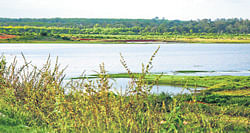Even as there is a debate all over the world about saving existing grasslands and rehabilitating degraded ones, Hesaraghatta’s grasslands, the last of such ecosystems around Bangalore, are under threat, writes Seema Hegde

Grasslands are the result of the lack of irregular rainfall to support the growth of a forest, but not so little to form a desert. They have grass as their dominant vegetation with a few thorny bushes of leguminous species and very few trees. They form a complex ecosystem of reptiles, birds, insects, beetles, bees and other crop pollinators and any disturbance to these grasslands would directly affect its inhabitants and indirectly affect humans by reducing the crop yield.
Forests or water are often associations that come up when one talks of conservation, but one hardly realises that scrub, thorny and grassland habitats are also needed for maintaining biodiversity. They need to be conserved for various ecosystem services they provide.
Grasslands are often mistaken for wastelands. It is wrongly perceived that the tangible (or direct) benefits society receives from grasslands are few as compared to what it receives from croplands or forestlands and hence, grasslands are given lesser importance and attention than croplands and forest lands.
A direct benefit from grasslands as perceived by society is providing fodder for cattle. But other intangible benefits like an increase in ground water level, prevention of soil erosion, and harbouring a variety of birds, and insects are not easily perceived. In many cases, grasslands are converted either into agricultural lands by ploughing and treating the land with chemical fertilisers, or into forest lands by planting fast-growing exotic species.
According to a survey by National Geographic, about a quarter of earth’s land is covered with grasslands, but many of these lands have been converted into farms.
Conversion of grasslands into croplands or forest lands or use of grasslands in other money-making projects is happening all around the world. In India also, there has been a deterioration of grasslands over the years due to both natural and anthropogenic reasons. Natural reasons like extreme temperature, variable precipitation, insufficient moisture and anthropogenic reasons like large cattle population, free and uncontrolled livestock grazing, modification of land for agriculture, conversion of grasslands into plantations for industrial use, and poor management have turned the grasslands into a really bad shape.
Dwindling bird species
The report of the Task Force on Grasslands and Deserts by the Planning Commission of India in its executive summary says that “grasslands and deserts are the most neglected ecosystems by the Ministry of Environment and Forests which looks after biodiversity conservation in India. Many natural grasslands have been converted to plantations, sometimes even in protected areas (PAs). In spite of the importance of grasslands and deserts for biodiversity conservation, livestock dependency and for poverty alleviation, we still do not have Grassland Development and Grazing Policy in place.”
Disturbance in grasslands is the main reason for the loss of many birds including the Great Indian Bustard. The Bombay Natural History Society has estimated that there are 600-700 of these birds in India.
Even as there is a debate around the world about saving existing grasslands and rehabilitating degraded ones, the grasslands of Hesaraghatta, the last surviving grasslands around Bangalore supporting a variety of fauna are under threat. It is an area of 305 acres owned by the Department of Animal Husbandry, Government of Karnataka.
It provides habitat to many migratory birds from Europe and Central Asia and also to one of the most threatened Indian birds, the lesser Florican, listed under the Schedule-I of endangered birds. Any disturbance caused to these grasslands threatens the life of the birds and other dependent fauna, and affects the chain system of the nature, and ultimately leads to ecological imbalance which we can never imagine.
Many ecological services
Residents of Bangalore may not realise it, but grasslands of Hesaraghatta provide many valuable ecosystem services to them. It is the catchment area for Hesaraghatta tank. These grasslands act as sponges, absorbing rain water and releasing it slowly into the lake. Rejuvenation of Arkavathi river basin or Hesaraghatta lake would not have any meaning if these grasslands are disturbed. These grasslands, once known for their beauty, have seen extensive littering by picnicking people and film shoot teams. There is talk of a theme park or a film city coming up, and the grasslands are under serious threat.
Researchers and scientists opine that in India, there is no special department designated to the conservation of grasslands. The Irrigation Department aims to convert grasslands into croplands and the Forest Department aims to plant trees on it. It is true that after the monsoon, the grasslands really look barren, but they really are not. The grass on the surface dies, but grows again as the stumps and seeds are underground. Even barren grasslands during summer support life and should not be disturbed and converted to land for construction. With proper protection and management, degraded grasslands can be restored to their original form.
Hesaraghatta grasslands need to be protected. It is necessary for the government and the public to understand the role of grasslands in biodiversity conservation and take immediate steps to conserve them.
No doubt, there is a necessity to conserve forest ecosystems, but at the same time there is an absolute necessity to save the grassland ecosystems as well.